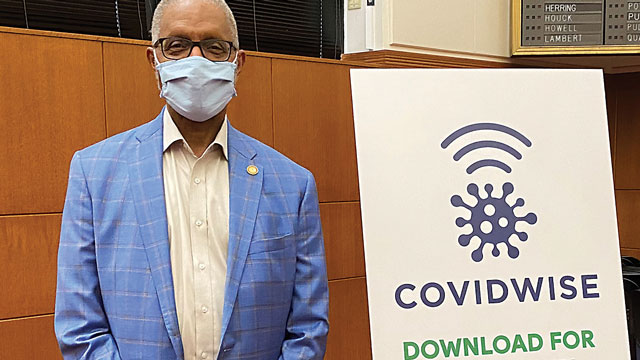As lead contact tracer for the Virginia Department of Health, Delaney Savedge is squarely focused on finding the most efficient way to interview people with COVID-19 in an effort to reach others who may have been exposed to the virus.
Savedge, who recently graduated from Virginia Commonwealth University with a degree in health science, thought work as a contact tracer was an effective way to help the community during this pandemic.
“I can use my degree and do something good,” she says, adding that all contact tracers must go through an extensive training program.
Even though contact tracing has been front and center recently with the pandemic, it isn’t a new idea. It is a fundamental part of public health, and state and local health departments have used it for decades.

“There are lots of conditions that are reportable to the health department. Contact tracing is part of investigations for diseases like whooping cough and tuberculosis,” says Marshall Vogt, division epidemiologist for the Virginia Department of Health who is leading VDH’s contact-tracing effort. “We want to see who people have been in contact with and where they have been contagious or infectious.”
Vogt says that although contact tracing is a standard public health strategy, it has never been applied to an illness like COVID-19. “We’ve never done it at this scale before,” he adds.
The VDH started contact tracing as soon as the department became aware of the first case of COVID-19. “We’ve been contact tracing for COVID since day one,” Vogt says. “We’ve expanded and enhanced our workforce. We’ve responded to changes and cases of COVID, and that is one of the ways – along with social distancing and a vaccine in late 2020/early 2021 – we are going to take care of the virus.”
Tracing the contacts of an individual who tests positive for COVID-19 is a critical tool in stopping the spread of this virus, according to Governor Ralph Northam. “Together with robust testing, contact tracing helps us identify hot spots and prevent them from becoming larger. That’s why one of our top priorities for the federal funding we have received has been to dramatically increase our testing capacity and hire additional contact tracers and case investigators,” says Governor Northam.
The Work of the Contact Tracer
Savedge interviews people with COVID-19 on the phone and receives contact information for people who may have been exposed to the virus. “We call them and tell them they are exposed and provide educational information about the quarantine and how to stay safe after being exposed,” she says. “We tell them where they can get tested, and we also continuously monitor their symptoms and how they are feeling. We are helping contain the disease as much as possible.”
It’s not uncommon for people to be skeptical when being interviewed by Savedge and other contact tracers, but all information collected from someone who has COVID-19 is confidential and adheres to HIPAA and privacy laws. A person’s name will not be revealed to those who have been exposed, even if the person who has been exposed asks for that information.
“The information is only being used for public health purposes and is kept confidential,” Savedge says. “It helps Virginia and the Centers for Disease Control be more aware of who is being affected so we can combat it [the spread of COVID] more effectively.”
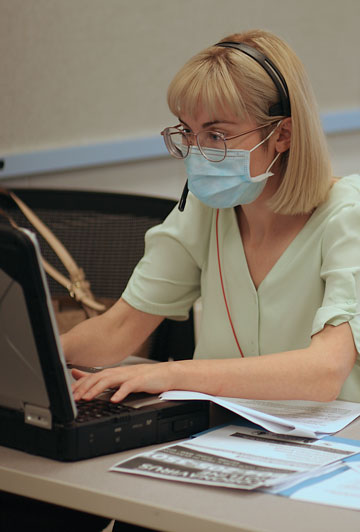
There have been a few instances where people have refused to talk to contact tracers, but Savedge says most people have been receptive and cooperative. “We’ve been able to quell their fears about speaking to us,” Savedge says.
With each of her calls, Savedge tries to establish relationships with patients and contacts. “We want to let them know the health department is here for them,” she says.
Approximately 80 percent of the people contacted are already aware of their exposure, she adds. Savedge says her team is also in charge of making sure that Virginia workplaces know if someone in their company has tested positive, and they provide the criteria to follow if an employee is exposed.
Keeping a Community Focus
At the time of this writing, there were more than 1,500 full-time people working on contact tracing in Virginia. This force for public
health includes nurses, investigators, epidemiologists, employees, volunteers, and contractors.
“The idea is to have somebody who is a part of the local community,” says Vogt. “We want people to establish relationships to get a response of trust. We take confidentiality very seriously.”
The department is continuing to hire. “We want to grow the contact tracing workforce should we have increases in cases in the state,” says Vogt. “We want to keep the level we need to help contain COVID-19.”
About 30 percent of cases might occur in people who don’t show symptoms, which means no reporting or subsequent contact tracing takes place. That’s why, Vogt says, wearing a mask is an important way to reduce the spread of COVID-19. “They [masks] help to contain and reduce the secretions that come out from the nose and mouth. When you wear a mask, you are protecting others. When everybody wears a mask, it makes it hard for the virus to spread in the community.”
Volunteers Join the Force
Jennifer Freeland, the state volunteer coordinator at VDH’s office of emergency preparedness, leads the Virginia Medical Reserve Corps program, a federal government program that was created following 9/11 in an effort to streamline a process to mobilize medical volunteers.
The Corps addresses everything from the opioid epidemic to COVID-19. Medical Reserve Corps units support a variety of COVID-19 operations including contact tracing, community testing, handing out flyers about free testing, and fit-testing N95 masks for healthcare providers.
By late July, forty-nine volunteers in the Chickahominy, Richmond, and Henrico MRC units had provided nearly 2,000 volunteer hours in call centers. In Chesterfield, thirty-four volunteers have served as contact tracers with more than 800 hours contributed. Volunteers serving in public information and contact tracing positions are fully trained and normally have either a medical background or superior customer service skills. Freeland says many people are part of this team. “Contact tracers are probably your neighbor, your friend.”
The VDH is still looking for volunteers, especially Spanish interpreters to help with contact tracing. “If anyone feels like they want to help, that would be great. We are not anywhere close to being done,” says Freeland, adding that the volunteer force is starting to prepare for an information campaign related to a program for COVID-19 vaccinations.
Freeland says most people are compliant with contact tracing, mask wearing, and testing, but there are people who get caught up in what she called the “it’s all about me and less about the community” mindset.
New Tech to Combat COVID
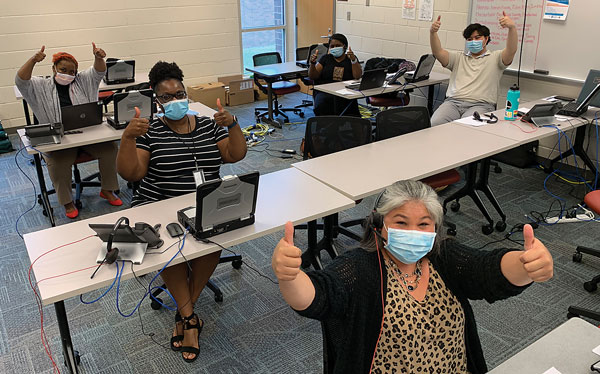
The VDH started working on its exposure notification app for use by the public in late May and released it in August. The app, called COVIDWISE, uses the framework that Apple and Google developed, which protects the privacy of those who download the app. The success of the app is dependent on the number of people who first download it, and then report a positive COVID result if applicable.
“While several other states have already released exposure notification apps that track location information through GPS, COVIDWISE does not collect, store, or transmit any location data or personal information to VDH,” says VDH spokesperson Julie Grimes. “Because
of concern for people’s privacy, Virginia may be the first state in the nation to make this type of app available to its citizenry.”
At least twelve countries, including Germany, Ireland, Japan and Italy, are using the Google and Apple framework. “If you want it to work effectively, people have to have the app on their phone and people who they come in contact with have to have it,” Grimes says. “The more Virginians who use COVIDWISE, the greater the likelihood that you will receive timely exposure notifications that lead to effective disease prevention.”
Helping Latinx Families
Agnes Alamo-Ramos, who has a nursing degree and is a Spanish speaker, began her job as a contact tracer in mid-summer. She took the job because she wanted to help Spanish-speaking people get through this pandemic.
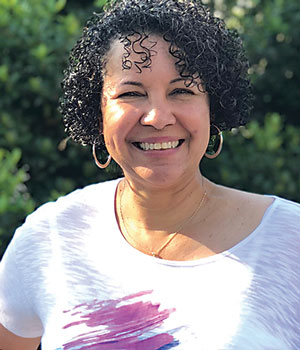
Some of the people she talks with are reluctant to provide any information. “They will ask me why I want to know their address or birthday,” says Alamo-Ramos. “They don’t want to talk to you.”
Sometimes she encounters people who can’t read or write and don’t understand the message she leaves on the phone. “There are days that are very frustrating. No one is answering calls or calling me back and that makes me upset,” she says.
Most people she calls, however, are receptive. “Some people will tell you their story, and they will ask a lot of questions. Sometimes they will call me back to ask more questions,” she says. “Sometimes they don’t know where to go for testing, especially if they don’t have insurance or Medicare. I can help them a lot.”
She enjoys answering people’s questions and referring them to resources.
How Another Country Has Fared
Thomas Streetman lives in South Korea with his family where he works as a marketing director for a video game studio.
He says South Korea began using contact tracing nationally from the start of COVID. The country had experienced a similar coronavirus scare with the SARS outbreak in the mid 2000s and again with MERS in 2014.
“By using the experience they had from previous outbreaks and learning from what worked in other countries, they had a plan in place from the beginning that involved contact tracing among other things,” says Streetman.
When someone is confirmed with a COVID infection, the public safety/health board interviews patients about their whereabouts over the previous week, “down to the little trips to the convenience store or to taking out the trash,” Streetman says. “They then immediately send out a cleaning team and contact those businesses and locations to lock down. Immediate family members and coworkers are also put into quarantine.”
The local city/provincial governments use the public alert system to send updates to every cell phone within their service region.
Streetman says while he understands people’s concerns with privacy and sharing personal information with contact tracers, he stays focused on the broader public health goal. “The reason for the collection [of information] is literally to save lives.”
Because mask-wearing has been a part of Korean culture for a while, the need to wear them during the pandemic is not causing angst among South Koreans. “East Asian work culture often discourages people from taking sick days, so people wear the masks to come to work when perhaps in the West people would stay home from work,” he adds. “It’s not uncommon to see people walking down the street with a mask on even when there wasn’t a pandemic.”
While life is not back to normal in South Korea, there is a new normal. Some schools are back in session at staggered levels, private academies have been operating at limited capacity, and theaters have opened.
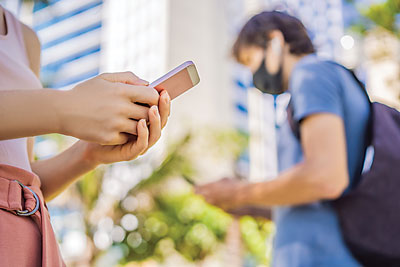 Streetman sees contact tracing as a very important part of how South Korea has contained the spread of the virus. “Korea is much more densely populated than the U.S. with the population of Texas living in an area smaller than Connecticut. Korea is also not a car-use country, with the vast majority of the population using public transportation, resulting in a lot more chance for spread,” he says. “Contact tracing allowed people to be involved on a more personal level.”
Streetman sees contact tracing as a very important part of how South Korea has contained the spread of the virus. “Korea is much more densely populated than the U.S. with the population of Texas living in an area smaller than Connecticut. Korea is also not a car-use country, with the vast majority of the population using public transportation, resulting in a lot more chance for spread,” he says. “Contact tracing allowed people to be involved on a more personal level.”
Freeland with the VDH says that with COVID-19 still gripping many regions across the United States, the key to keeping it in check is cooperation throughout the community, similar to the kind of community cooperation that has happened in South Korea. “It’s all hands on deck,” Freeland says. “We all want to be out in the community and doing the things we enjoy, but sometimes we have to be mindful and flexible. We all have our social responsibility. We want to protect the people around us and have them protect us.”
photos: Joe Kutchera


